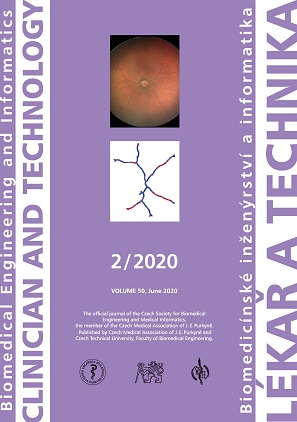PREMATURE INFANT BLOOD VESSEL SEGMENTATION OF RETINAL IMAGES BASED ON HYBRID METHOD FOR THE DETERMINATION OF TORTUOSITY
DOI:
https://doi.org/10.14311/CTJ.2020.2.02Keywords:
Segmentation, Retinal Blood Vessels, Curvature, Morphology, TortuosityAbstract
For the retinal blood vessels segmentation, we used a method, which is based on the morphological operations. The output of this process is extracted retinal binary image, where is situated main blood vessels. In this paper is used dataset of images (2800 images) from device RetCam3. Before applying the image processing, it was selected 30 images with diagnosed pre-plus diseases, and it is divided into two groups with low contrast and good contrast images. In the next part of the analysis, it was analyzing and showing blood vessels with tortuosity. Tortuosity is a symptom of ROP (retinopathy of prematurity). The clinical physicians evaluate tortuosity by visual comparison of the retinal images images. For this reason, it was suggested model which can automatically indicate the tortuosity of the retinal blood vessels by setting a threshold of the blood vessels curvature.
Downloads
Published
Issue
Section
License
Copyright (c) 2021 Alice Krestanova

This work is licensed under a Creative Commons Attribution 4.0 International License.
Authors who publish with this journal agree to the following terms:
- Authors retain copyright and grant the journal right of the first publication with the work simultaneously licensed under a Creative Commons Attribution License (https://creativecommons.org/licenses/by/4.0/) that allows others to share the work with an acknowledgment of the work's authorship and initial publication in CTJ.
- Authors are able to enter into separate, additional contractual arrangements for the non-exclusive distribution of the journal’s published version of the work (e.g., post it to an institutional repository or publish it in a book), with an acknowledgment of its initial publication in this journal.
- Authors are permitted and encouraged to post their work online (e.g., in institutional repositories or on their website or ResearchGate) prior to and during the submission process, as it can lead to productive exchanges.
CTJ requires that all of the content of the manuscript has been created by its respective authors or that permission to use a copyrighted material has been obtained by the authors before submitting the manuscript to CTJ. CTJ requires that authors have not used any copyrighted material illegally, as for example a picture from another journal or book, a photo, etc. It is the author’s responsibility to use only materials not violating the copyright law. When in doubt, CTJ may ask the authors to supply the pertinent permission or agreement about the use of a copyrighted material.
The opinions expressed in CTJ articles are those of authors and do not necessarily reflect the views of the publishers or the Czech Society for Biomedical Engineering and Medical Informatics.


